Impact of Culture, Power and Politics on Employee Performance
VerifiedAdded on 2023/01/05
|14
|3504
|59
AI Summary
This report analyzes the impact of organizational culture, power, and politics on employee performance. It also examines the effectiveness of motivational theories and the concept of organizational behavior. Case study: Sainsbury.
Contribute Materials
Your contribution can guide someone’s learning journey. Share your
documents today.
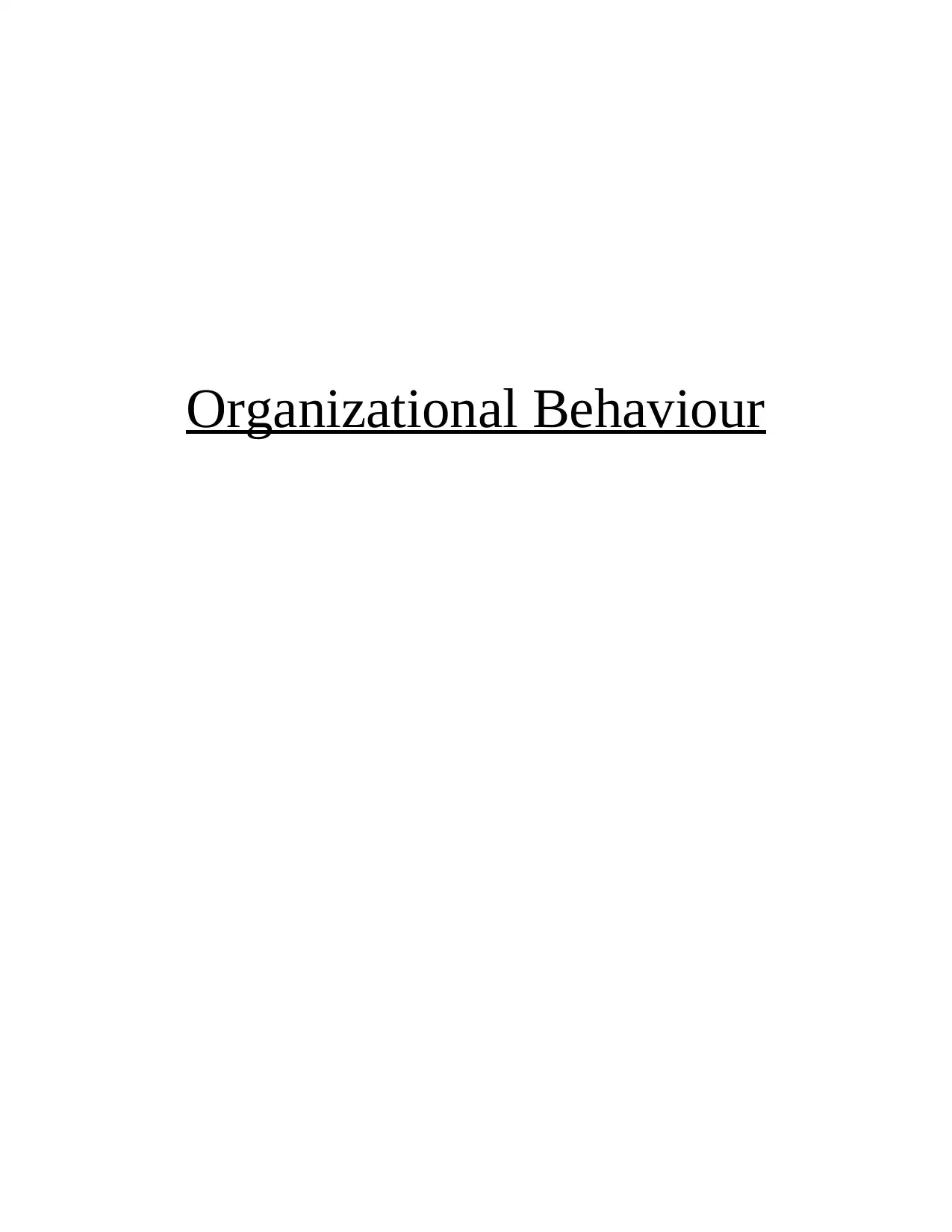
Organizational Behaviour
Secure Best Marks with AI Grader
Need help grading? Try our AI Grader for instant feedback on your assignments.
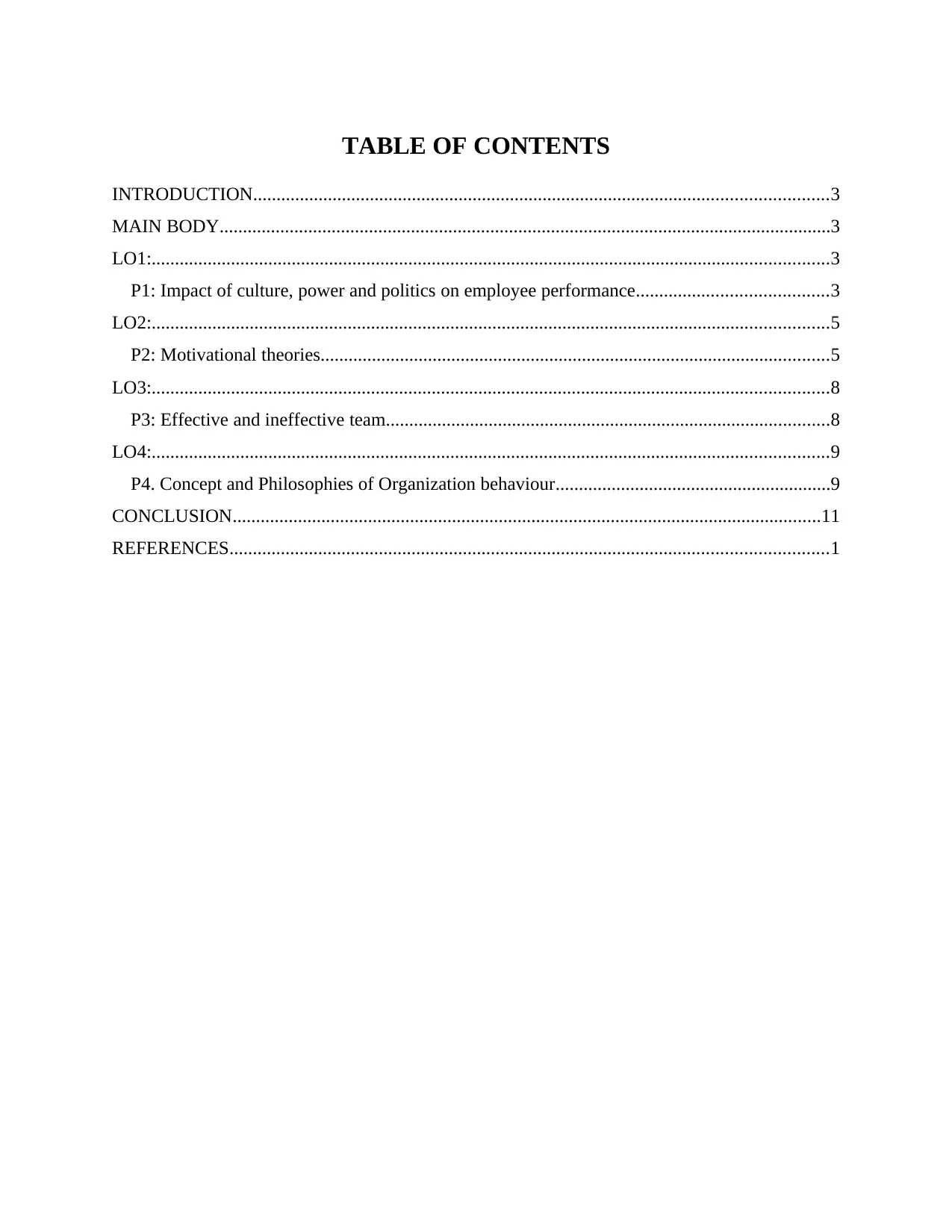
TABLE OF CONTENTS
INTRODUCTION...........................................................................................................................3
MAIN BODY...................................................................................................................................3
LO1:.................................................................................................................................................3
P1: Impact of culture, power and politics on employee performance.........................................3
LO2:.................................................................................................................................................5
P2: Motivational theories.............................................................................................................5
LO3:.................................................................................................................................................8
P3: Effective and ineffective team...............................................................................................8
LO4:.................................................................................................................................................9
P4. Concept and Philosophies of Organization behaviour...........................................................9
CONCLUSION..............................................................................................................................11
REFERENCES................................................................................................................................1
INTRODUCTION...........................................................................................................................3
MAIN BODY...................................................................................................................................3
LO1:.................................................................................................................................................3
P1: Impact of culture, power and politics on employee performance.........................................3
LO2:.................................................................................................................................................5
P2: Motivational theories.............................................................................................................5
LO3:.................................................................................................................................................8
P3: Effective and ineffective team...............................................................................................8
LO4:.................................................................................................................................................9
P4. Concept and Philosophies of Organization behaviour...........................................................9
CONCLUSION..............................................................................................................................11
REFERENCES................................................................................................................................1

INTRODUCTION
Organizational behaviour is used by organizations for analysing the performance of
individual and group of employees. This analysis is used for implementing organizational
changes such that it will make an positive impact on employee performance. Sainsbury is chosen
for the analysis in this report. It is one of the largest supermarket chain of UK which provide
wide range of house hold equipments and grocery products to its customers. The report will
analyse the impact of organizational power, work culture and organizational politics on
employee performance. Effectiveness of motivational theories on employee performance will
also be done in this report. Analysis of effective and ineffective team is also done in this report.
Impact of implementation of organizational philosophies and concepts within an organizational
behaviour is also done in this report.
MAIN BODY
LO1:
P1: Impact of culture, power and politics on employee performance
Following is the impact of organizational culture on team behaviour and performance.
Culture
Organizational culture is the way in which individual employees tend to work in proper
collaboration with each other for achieving a common goal. Following are the different types of
organizational cultures.
Power Culture-
In this only higher organizational authorities are responsible for decision-making and
other employees have to follow the orders. This will limit employee creativity at Sainsbury
because they are only following the orders provided to them, resulting decrement in company's
performance.
Role Culture-
Employees are empowered according to the position within organization this will
motivate them to work according to their position. Sainsbury will get high level of control over
its organizational activities but because of long chain of commands organizational improvement
will take time.
Task Culture-
Organizational behaviour is used by organizations for analysing the performance of
individual and group of employees. This analysis is used for implementing organizational
changes such that it will make an positive impact on employee performance. Sainsbury is chosen
for the analysis in this report. It is one of the largest supermarket chain of UK which provide
wide range of house hold equipments and grocery products to its customers. The report will
analyse the impact of organizational power, work culture and organizational politics on
employee performance. Effectiveness of motivational theories on employee performance will
also be done in this report. Analysis of effective and ineffective team is also done in this report.
Impact of implementation of organizational philosophies and concepts within an organizational
behaviour is also done in this report.
MAIN BODY
LO1:
P1: Impact of culture, power and politics on employee performance
Following is the impact of organizational culture on team behaviour and performance.
Culture
Organizational culture is the way in which individual employees tend to work in proper
collaboration with each other for achieving a common goal. Following are the different types of
organizational cultures.
Power Culture-
In this only higher organizational authorities are responsible for decision-making and
other employees have to follow the orders. This will limit employee creativity at Sainsbury
because they are only following the orders provided to them, resulting decrement in company's
performance.
Role Culture-
Employees are empowered according to the position within organization this will
motivate them to work according to their position. Sainsbury will get high level of control over
its organizational activities but because of long chain of commands organizational improvement
will take time.
Task Culture-
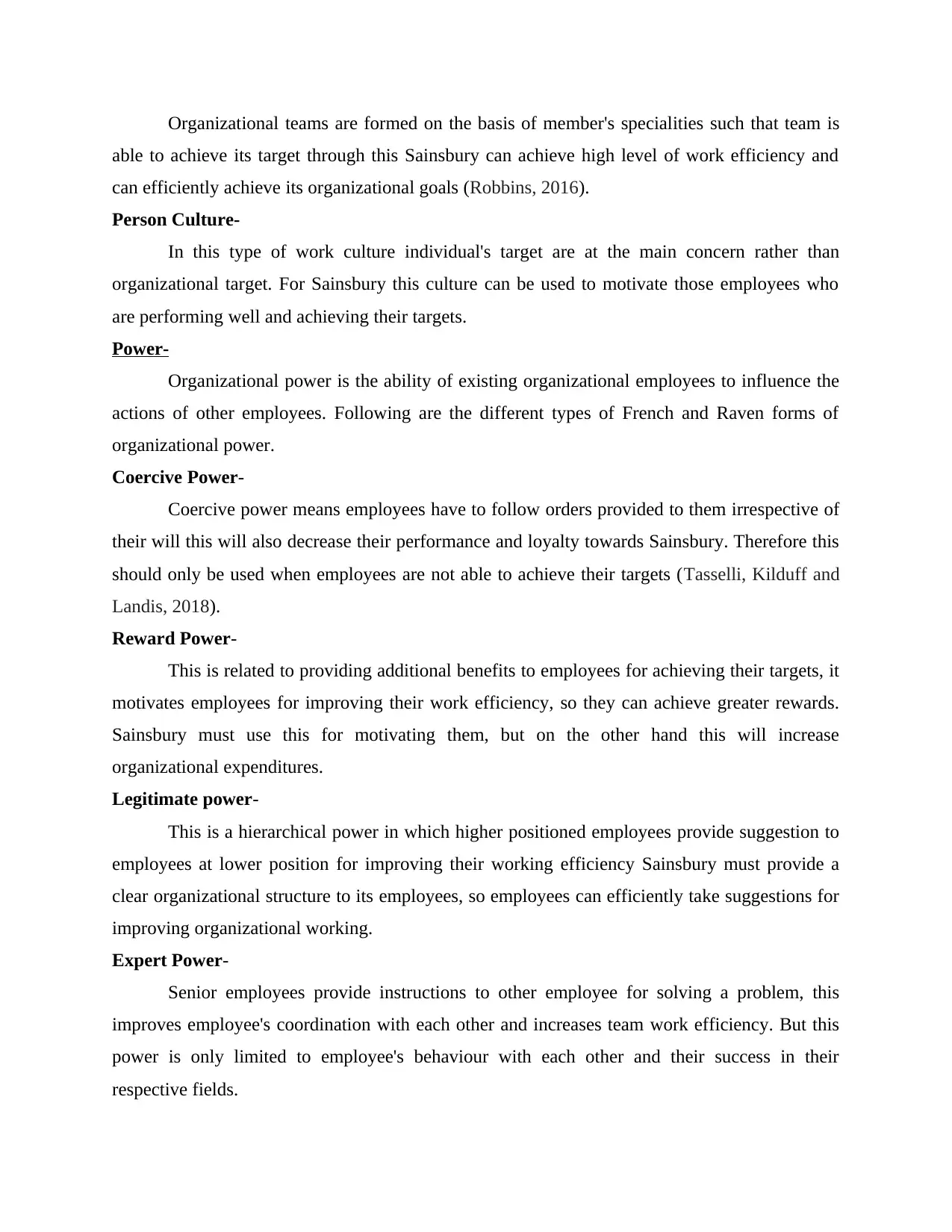
Organizational teams are formed on the basis of member's specialities such that team is
able to achieve its target through this Sainsbury can achieve high level of work efficiency and
can efficiently achieve its organizational goals (Robbins, 2016).
Person Culture-
In this type of work culture individual's target are at the main concern rather than
organizational target. For Sainsbury this culture can be used to motivate those employees who
are performing well and achieving their targets.
Power-
Organizational power is the ability of existing organizational employees to influence the
actions of other employees. Following are the different types of French and Raven forms of
organizational power.
Coercive Power-
Coercive power means employees have to follow orders provided to them irrespective of
their will this will also decrease their performance and loyalty towards Sainsbury. Therefore this
should only be used when employees are not able to achieve their targets (Tasselli, Kilduff and
Landis, 2018).
Reward Power-
This is related to providing additional benefits to employees for achieving their targets, it
motivates employees for improving their work efficiency, so they can achieve greater rewards.
Sainsbury must use this for motivating them, but on the other hand this will increase
organizational expenditures.
Legitimate power-
This is a hierarchical power in which higher positioned employees provide suggestion to
employees at lower position for improving their working efficiency Sainsbury must provide a
clear organizational structure to its employees, so employees can efficiently take suggestions for
improving organizational working.
Expert Power-
Senior employees provide instructions to other employee for solving a problem, this
improves employee's coordination with each other and increases team work efficiency. But this
power is only limited to employee's behaviour with each other and their success in their
respective fields.
able to achieve its target through this Sainsbury can achieve high level of work efficiency and
can efficiently achieve its organizational goals (Robbins, 2016).
Person Culture-
In this type of work culture individual's target are at the main concern rather than
organizational target. For Sainsbury this culture can be used to motivate those employees who
are performing well and achieving their targets.
Power-
Organizational power is the ability of existing organizational employees to influence the
actions of other employees. Following are the different types of French and Raven forms of
organizational power.
Coercive Power-
Coercive power means employees have to follow orders provided to them irrespective of
their will this will also decrease their performance and loyalty towards Sainsbury. Therefore this
should only be used when employees are not able to achieve their targets (Tasselli, Kilduff and
Landis, 2018).
Reward Power-
This is related to providing additional benefits to employees for achieving their targets, it
motivates employees for improving their work efficiency, so they can achieve greater rewards.
Sainsbury must use this for motivating them, but on the other hand this will increase
organizational expenditures.
Legitimate power-
This is a hierarchical power in which higher positioned employees provide suggestion to
employees at lower position for improving their working efficiency Sainsbury must provide a
clear organizational structure to its employees, so employees can efficiently take suggestions for
improving organizational working.
Expert Power-
Senior employees provide instructions to other employee for solving a problem, this
improves employee's coordination with each other and increases team work efficiency. But this
power is only limited to employee's behaviour with each other and their success in their
respective fields.
Secure Best Marks with AI Grader
Need help grading? Try our AI Grader for instant feedback on your assignments.
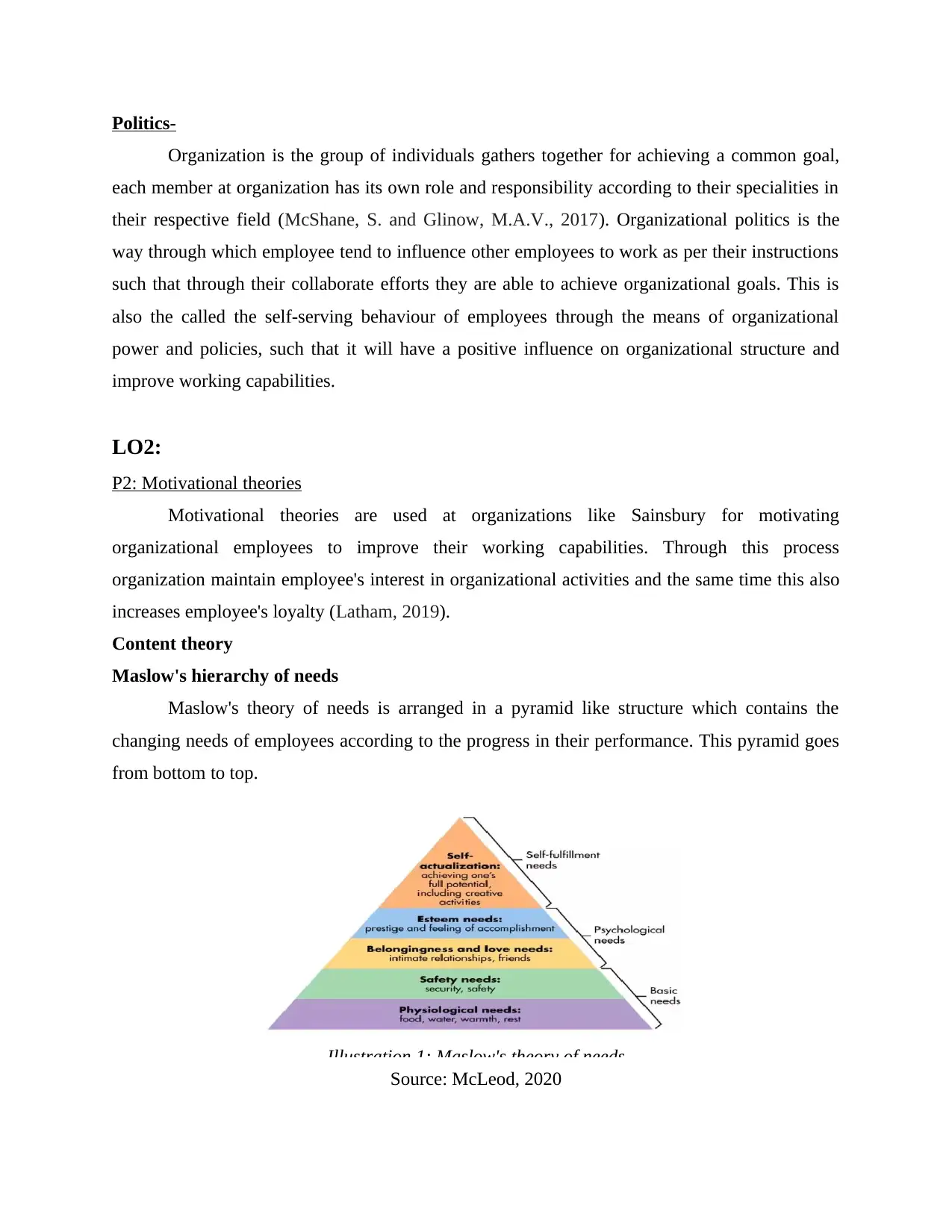
Politics-
Organization is the group of individuals gathers together for achieving a common goal,
each member at organization has its own role and responsibility according to their specialities in
their respective field (McShane, S. and Glinow, M.A.V., 2017). Organizational politics is the
way through which employee tend to influence other employees to work as per their instructions
such that through their collaborate efforts they are able to achieve organizational goals. This is
also the called the self-serving behaviour of employees through the means of organizational
power and policies, such that it will have a positive influence on organizational structure and
improve working capabilities.
LO2:
P2: Motivational theories
Motivational theories are used at organizations like Sainsbury for motivating
organizational employees to improve their working capabilities. Through this process
organization maintain employee's interest in organizational activities and the same time this also
increases employee's loyalty (Latham, 2019).
Content theory
Maslow's hierarchy of needs
Maslow's theory of needs is arranged in a pyramid like structure which contains the
changing needs of employees according to the progress in their performance. This pyramid goes
from bottom to top.
Source: McLeod, 2020
Illustration 1: Maslow's theory of needs
Organization is the group of individuals gathers together for achieving a common goal,
each member at organization has its own role and responsibility according to their specialities in
their respective field (McShane, S. and Glinow, M.A.V., 2017). Organizational politics is the
way through which employee tend to influence other employees to work as per their instructions
such that through their collaborate efforts they are able to achieve organizational goals. This is
also the called the self-serving behaviour of employees through the means of organizational
power and policies, such that it will have a positive influence on organizational structure and
improve working capabilities.
LO2:
P2: Motivational theories
Motivational theories are used at organizations like Sainsbury for motivating
organizational employees to improve their working capabilities. Through this process
organization maintain employee's interest in organizational activities and the same time this also
increases employee's loyalty (Latham, 2019).
Content theory
Maslow's hierarchy of needs
Maslow's theory of needs is arranged in a pyramid like structure which contains the
changing needs of employees according to the progress in their performance. This pyramid goes
from bottom to top.
Source: McLeod, 2020
Illustration 1: Maslow's theory of needs
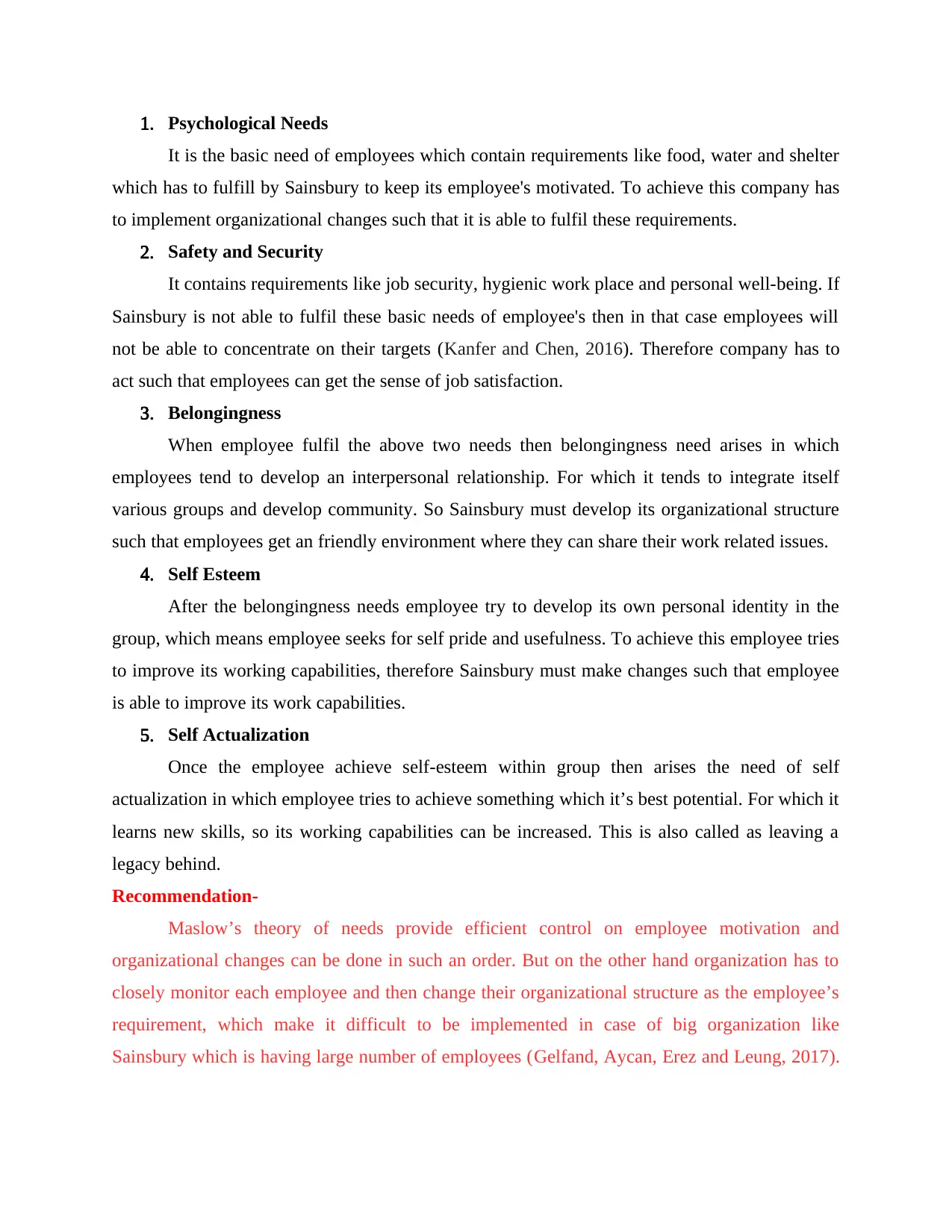
1. Psychological Needs
It is the basic need of employees which contain requirements like food, water and shelter
which has to fulfill by Sainsbury to keep its employee's motivated. To achieve this company has
to implement organizational changes such that it is able to fulfil these requirements.
2. Safety and Security
It contains requirements like job security, hygienic work place and personal well-being. If
Sainsbury is not able to fulfil these basic needs of employee's then in that case employees will
not be able to concentrate on their targets (Kanfer and Chen, 2016). Therefore company has to
act such that employees can get the sense of job satisfaction.
3. Belongingness
When employee fulfil the above two needs then belongingness need arises in which
employees tend to develop an interpersonal relationship. For which it tends to integrate itself
various groups and develop community. So Sainsbury must develop its organizational structure
such that employees get an friendly environment where they can share their work related issues.
4. Self Esteem
After the belongingness needs employee try to develop its own personal identity in the
group, which means employee seeks for self pride and usefulness. To achieve this employee tries
to improve its working capabilities, therefore Sainsbury must make changes such that employee
is able to improve its work capabilities.
5. Self Actualization
Once the employee achieve self-esteem within group then arises the need of self
actualization in which employee tries to achieve something which it’s best potential. For which it
learns new skills, so its working capabilities can be increased. This is also called as leaving a
legacy behind.
Recommendation-
Maslow’s theory of needs provide efficient control on employee motivation and
organizational changes can be done in such an order. But on the other hand organization has to
closely monitor each employee and then change their organizational structure as the employee’s
requirement, which make it difficult to be implemented in case of big organization like
Sainsbury which is having large number of employees (Gelfand, Aycan, Erez and Leung, 2017).
It is the basic need of employees which contain requirements like food, water and shelter
which has to fulfill by Sainsbury to keep its employee's motivated. To achieve this company has
to implement organizational changes such that it is able to fulfil these requirements.
2. Safety and Security
It contains requirements like job security, hygienic work place and personal well-being. If
Sainsbury is not able to fulfil these basic needs of employee's then in that case employees will
not be able to concentrate on their targets (Kanfer and Chen, 2016). Therefore company has to
act such that employees can get the sense of job satisfaction.
3. Belongingness
When employee fulfil the above two needs then belongingness need arises in which
employees tend to develop an interpersonal relationship. For which it tends to integrate itself
various groups and develop community. So Sainsbury must develop its organizational structure
such that employees get an friendly environment where they can share their work related issues.
4. Self Esteem
After the belongingness needs employee try to develop its own personal identity in the
group, which means employee seeks for self pride and usefulness. To achieve this employee tries
to improve its working capabilities, therefore Sainsbury must make changes such that employee
is able to improve its work capabilities.
5. Self Actualization
Once the employee achieve self-esteem within group then arises the need of self
actualization in which employee tries to achieve something which it’s best potential. For which it
learns new skills, so its working capabilities can be increased. This is also called as leaving a
legacy behind.
Recommendation-
Maslow’s theory of needs provide efficient control on employee motivation and
organizational changes can be done in such an order. But on the other hand organization has to
closely monitor each employee and then change their organizational structure as the employee’s
requirement, which make it difficult to be implemented in case of big organization like
Sainsbury which is having large number of employees (Gelfand, Aycan, Erez and Leung, 2017).

Therefore this theory can only be implemented on specific organizational teams or higher
authorities rather than on whole organization.
Process theory
This theory of motivation is related to the behaviour of employee through which they
develop a target and tend to work such that they are able to achieve their target. Following is the
type of process theory of motivation.
Vroom's Expectancy Theory
It states that employee’s behaviour is directly affected by the conscious choices made
according to its environment such that it maximizes the pleasure and minimizes the pain.
Following are the segments of expectancy theorem.
1. Expectancy
It states that individuals will put more efforts if they believe for achieving the outcome of
their interest, through this employees will put more efforts in surpassing their limits (Gagné,
2018). Therefore, Sainsbury must concentrate on improving their employee motivation strategies
such that employees are assured of getting the outcome of their personal interest, this will
increase the probability of improving their performance.
2. Instrumentality
At this stage employees tend to analyse their performance with their respected target.
This analysis motivate employee to continuously improvise their performance such that they are
able to achieve their desired target. For doing so employee has to closely monitor their
performance and evaluate their goal achievement, therefore Sainsbury must develop its
organizational structure such that they are able to provide a proper guidance to employees such
that they are able to achieve their target which will improve organizational working of
Sainsbury.
3. Valence
In this stage employees places high values for achieving their targets such that they are
more likely to put more efforts for achieving their goals and are not focussing on other
distractions. This dedication of employee for achieving their target will motivate them for
improving their performance till they achieve their desired target (Wu and Lee, 2017). So
Sainsbury must develop its organizational structure such that employees are appointed with
authorities rather than on whole organization.
Process theory
This theory of motivation is related to the behaviour of employee through which they
develop a target and tend to work such that they are able to achieve their target. Following is the
type of process theory of motivation.
Vroom's Expectancy Theory
It states that employee’s behaviour is directly affected by the conscious choices made
according to its environment such that it maximizes the pleasure and minimizes the pain.
Following are the segments of expectancy theorem.
1. Expectancy
It states that individuals will put more efforts if they believe for achieving the outcome of
their interest, through this employees will put more efforts in surpassing their limits (Gagné,
2018). Therefore, Sainsbury must concentrate on improving their employee motivation strategies
such that employees are assured of getting the outcome of their personal interest, this will
increase the probability of improving their performance.
2. Instrumentality
At this stage employees tend to analyse their performance with their respected target.
This analysis motivate employee to continuously improvise their performance such that they are
able to achieve their desired target. For doing so employee has to closely monitor their
performance and evaluate their goal achievement, therefore Sainsbury must develop its
organizational structure such that they are able to provide a proper guidance to employees such
that they are able to achieve their target which will improve organizational working of
Sainsbury.
3. Valence
In this stage employees places high values for achieving their targets such that they are
more likely to put more efforts for achieving their goals and are not focussing on other
distractions. This dedication of employee for achieving their target will motivate them for
improving their performance till they achieve their desired target (Wu and Lee, 2017). So
Sainsbury must develop its organizational structure such that employees are appointed with
Paraphrase This Document
Need a fresh take? Get an instant paraphrase of this document with our AI Paraphraser
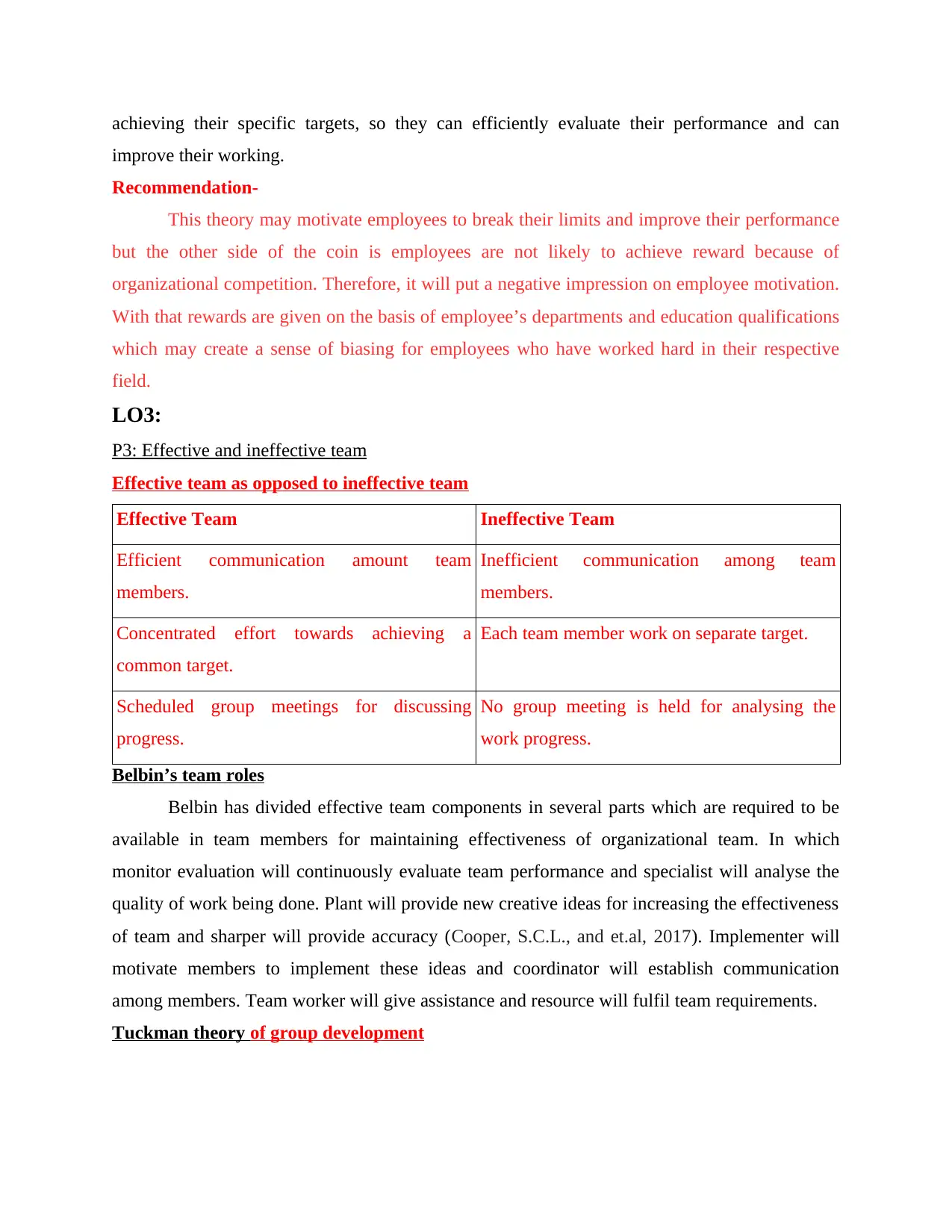
achieving their specific targets, so they can efficiently evaluate their performance and can
improve their working.
Recommendation-
This theory may motivate employees to break their limits and improve their performance
but the other side of the coin is employees are not likely to achieve reward because of
organizational competition. Therefore, it will put a negative impression on employee motivation.
With that rewards are given on the basis of employee’s departments and education qualifications
which may create a sense of biasing for employees who have worked hard in their respective
field.
LO3:
P3: Effective and ineffective team
Effective team as opposed to ineffective team
Effective Team Ineffective Team
Efficient communication amount team
members.
Inefficient communication among team
members.
Concentrated effort towards achieving a
common target.
Each team member work on separate target.
Scheduled group meetings for discussing
progress.
No group meeting is held for analysing the
work progress.
Belbin’s team roles
Belbin has divided effective team components in several parts which are required to be
available in team members for maintaining effectiveness of organizational team. In which
monitor evaluation will continuously evaluate team performance and specialist will analyse the
quality of work being done. Plant will provide new creative ideas for increasing the effectiveness
of team and sharper will provide accuracy (Cooper, S.C.L., and et.al, 2017). Implementer will
motivate members to implement these ideas and coordinator will establish communication
among members. Team worker will give assistance and resource will fulfil team requirements.
Tuckman theory of group development
improve their working.
Recommendation-
This theory may motivate employees to break their limits and improve their performance
but the other side of the coin is employees are not likely to achieve reward because of
organizational competition. Therefore, it will put a negative impression on employee motivation.
With that rewards are given on the basis of employee’s departments and education qualifications
which may create a sense of biasing for employees who have worked hard in their respective
field.
LO3:
P3: Effective and ineffective team
Effective team as opposed to ineffective team
Effective Team Ineffective Team
Efficient communication amount team
members.
Inefficient communication among team
members.
Concentrated effort towards achieving a
common target.
Each team member work on separate target.
Scheduled group meetings for discussing
progress.
No group meeting is held for analysing the
work progress.
Belbin’s team roles
Belbin has divided effective team components in several parts which are required to be
available in team members for maintaining effectiveness of organizational team. In which
monitor evaluation will continuously evaluate team performance and specialist will analyse the
quality of work being done. Plant will provide new creative ideas for increasing the effectiveness
of team and sharper will provide accuracy (Cooper, S.C.L., and et.al, 2017). Implementer will
motivate members to implement these ideas and coordinator will establish communication
among members. Team worker will give assistance and resource will fulfil team requirements.
Tuckman theory of group development
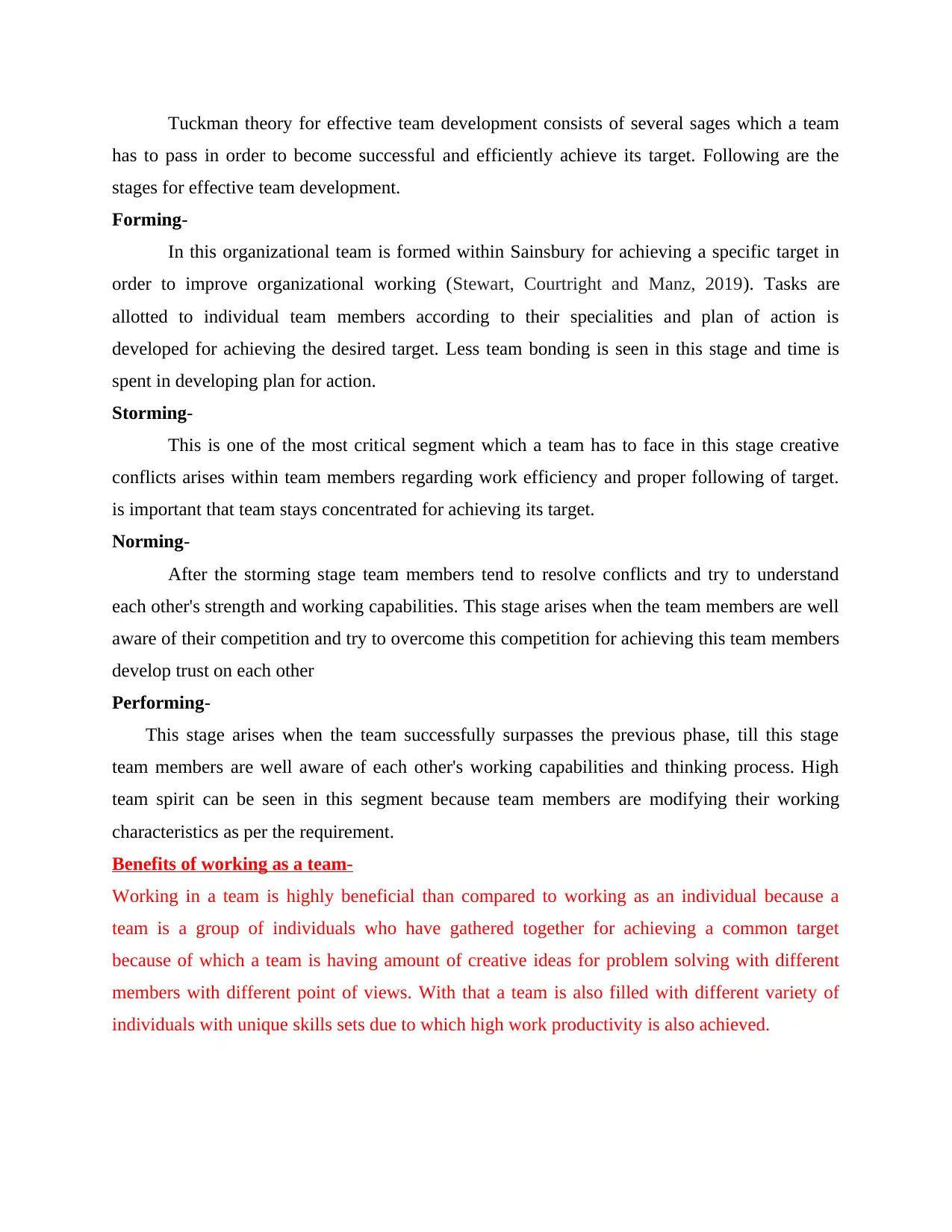
Tuckman theory for effective team development consists of several sages which a team
has to pass in order to become successful and efficiently achieve its target. Following are the
stages for effective team development.
Forming-
In this organizational team is formed within Sainsbury for achieving a specific target in
order to improve organizational working (Stewart, Courtright and Manz, 2019). Tasks are
allotted to individual team members according to their specialities and plan of action is
developed for achieving the desired target. Less team bonding is seen in this stage and time is
spent in developing plan for action.
Storming-
This is one of the most critical segment which a team has to face in this stage creative
conflicts arises within team members regarding work efficiency and proper following of target.
is important that team stays concentrated for achieving its target.
Norming-
After the storming stage team members tend to resolve conflicts and try to understand
each other's strength and working capabilities. This stage arises when the team members are well
aware of their competition and try to overcome this competition for achieving this team members
develop trust on each other
Performing-
This stage arises when the team successfully surpasses the previous phase, till this stage
team members are well aware of each other's working capabilities and thinking process. High
team spirit can be seen in this segment because team members are modifying their working
characteristics as per the requirement.
Benefits of working as a team-
Working in a team is highly beneficial than compared to working as an individual because a
team is a group of individuals who have gathered together for achieving a common target
because of which a team is having amount of creative ideas for problem solving with different
members with different point of views. With that a team is also filled with different variety of
individuals with unique skills sets due to which high work productivity is also achieved.
has to pass in order to become successful and efficiently achieve its target. Following are the
stages for effective team development.
Forming-
In this organizational team is formed within Sainsbury for achieving a specific target in
order to improve organizational working (Stewart, Courtright and Manz, 2019). Tasks are
allotted to individual team members according to their specialities and plan of action is
developed for achieving the desired target. Less team bonding is seen in this stage and time is
spent in developing plan for action.
Storming-
This is one of the most critical segment which a team has to face in this stage creative
conflicts arises within team members regarding work efficiency and proper following of target.
is important that team stays concentrated for achieving its target.
Norming-
After the storming stage team members tend to resolve conflicts and try to understand
each other's strength and working capabilities. This stage arises when the team members are well
aware of their competition and try to overcome this competition for achieving this team members
develop trust on each other
Performing-
This stage arises when the team successfully surpasses the previous phase, till this stage
team members are well aware of each other's working capabilities and thinking process. High
team spirit can be seen in this segment because team members are modifying their working
characteristics as per the requirement.
Benefits of working as a team-
Working in a team is highly beneficial than compared to working as an individual because a
team is a group of individuals who have gathered together for achieving a common target
because of which a team is having amount of creative ideas for problem solving with different
members with different point of views. With that a team is also filled with different variety of
individuals with unique skills sets due to which high work productivity is also achieved.
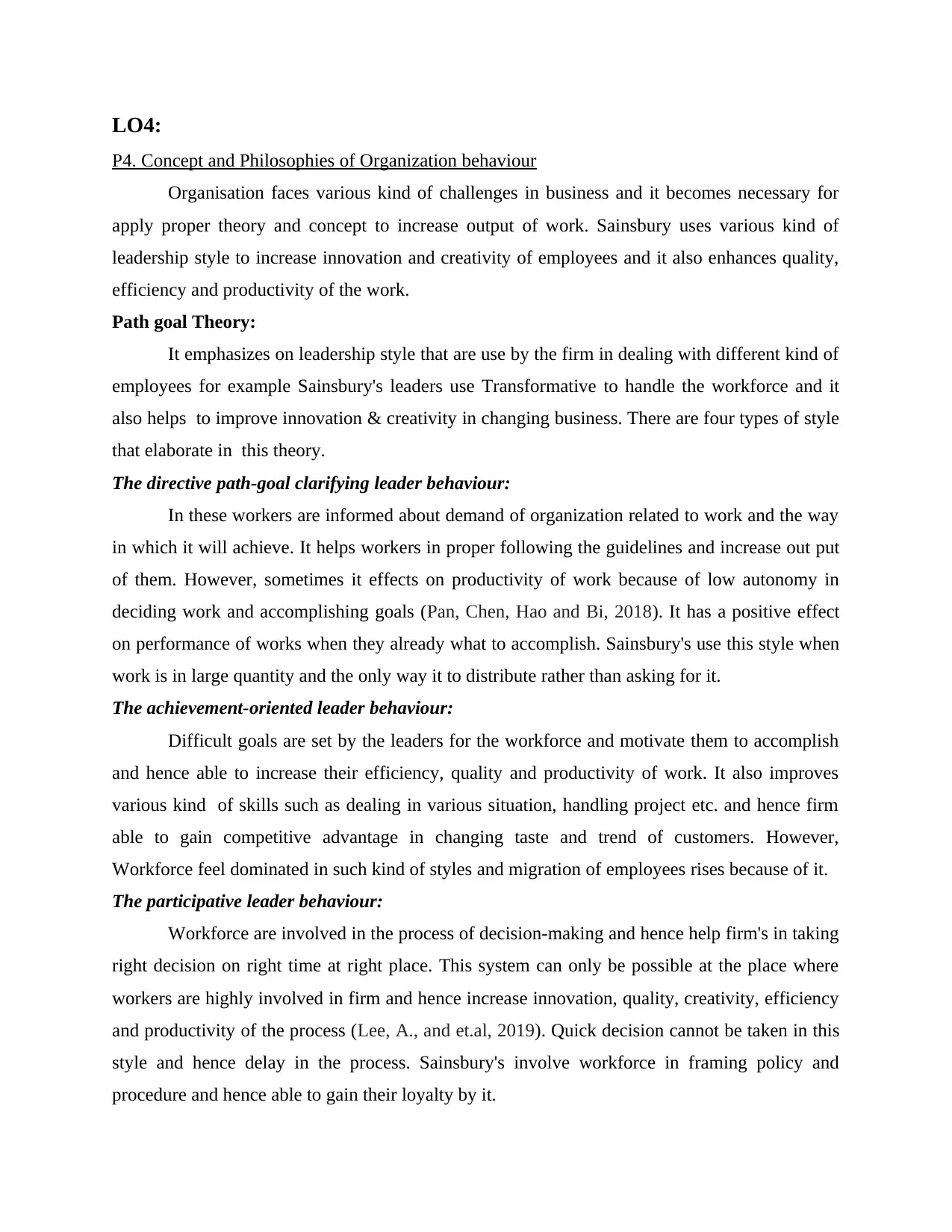
LO4:
P4. Concept and Philosophies of Organization behaviour
Organisation faces various kind of challenges in business and it becomes necessary for
apply proper theory and concept to increase output of work. Sainsbury uses various kind of
leadership style to increase innovation and creativity of employees and it also enhances quality,
efficiency and productivity of the work.
Path goal Theory:
It emphasizes on leadership style that are use by the firm in dealing with different kind of
employees for example Sainsbury's leaders use Transformative to handle the workforce and it
also helps to improve innovation & creativity in changing business. There are four types of style
that elaborate in this theory.
The directive path-goal clarifying leader behaviour:
In these workers are informed about demand of organization related to work and the way
in which it will achieve. It helps workers in proper following the guidelines and increase out put
of them. However, sometimes it effects on productivity of work because of low autonomy in
deciding work and accomplishing goals (Pan, Chen, Hao and Bi, 2018). It has a positive effect
on performance of works when they already what to accomplish. Sainsbury's use this style when
work is in large quantity and the only way it to distribute rather than asking for it.
The achievement-oriented leader behaviour:
Difficult goals are set by the leaders for the workforce and motivate them to accomplish
and hence able to increase their efficiency, quality and productivity of work. It also improves
various kind of skills such as dealing in various situation, handling project etc. and hence firm
able to gain competitive advantage in changing taste and trend of customers. However,
Workforce feel dominated in such kind of styles and migration of employees rises because of it.
The participative leader behaviour:
Workforce are involved in the process of decision-making and hence help firm's in taking
right decision on right time at right place. This system can only be possible at the place where
workers are highly involved in firm and hence increase innovation, quality, creativity, efficiency
and productivity of the process (Lee, A., and et.al, 2019). Quick decision cannot be taken in this
style and hence delay in the process. Sainsbury's involve workforce in framing policy and
procedure and hence able to gain their loyalty by it.
P4. Concept and Philosophies of Organization behaviour
Organisation faces various kind of challenges in business and it becomes necessary for
apply proper theory and concept to increase output of work. Sainsbury uses various kind of
leadership style to increase innovation and creativity of employees and it also enhances quality,
efficiency and productivity of the work.
Path goal Theory:
It emphasizes on leadership style that are use by the firm in dealing with different kind of
employees for example Sainsbury's leaders use Transformative to handle the workforce and it
also helps to improve innovation & creativity in changing business. There are four types of style
that elaborate in this theory.
The directive path-goal clarifying leader behaviour:
In these workers are informed about demand of organization related to work and the way
in which it will achieve. It helps workers in proper following the guidelines and increase out put
of them. However, sometimes it effects on productivity of work because of low autonomy in
deciding work and accomplishing goals (Pan, Chen, Hao and Bi, 2018). It has a positive effect
on performance of works when they already what to accomplish. Sainsbury's use this style when
work is in large quantity and the only way it to distribute rather than asking for it.
The achievement-oriented leader behaviour:
Difficult goals are set by the leaders for the workforce and motivate them to accomplish
and hence able to increase their efficiency, quality and productivity of work. It also improves
various kind of skills such as dealing in various situation, handling project etc. and hence firm
able to gain competitive advantage in changing taste and trend of customers. However,
Workforce feel dominated in such kind of styles and migration of employees rises because of it.
The participative leader behaviour:
Workforce are involved in the process of decision-making and hence help firm's in taking
right decision on right time at right place. This system can only be possible at the place where
workers are highly involved in firm and hence increase innovation, quality, creativity, efficiency
and productivity of the process (Lee, A., and et.al, 2019). Quick decision cannot be taken in this
style and hence delay in the process. Sainsbury's involve workforce in framing policy and
procedure and hence able to gain their loyalty by it.
Secure Best Marks with AI Grader
Need help grading? Try our AI Grader for instant feedback on your assignments.
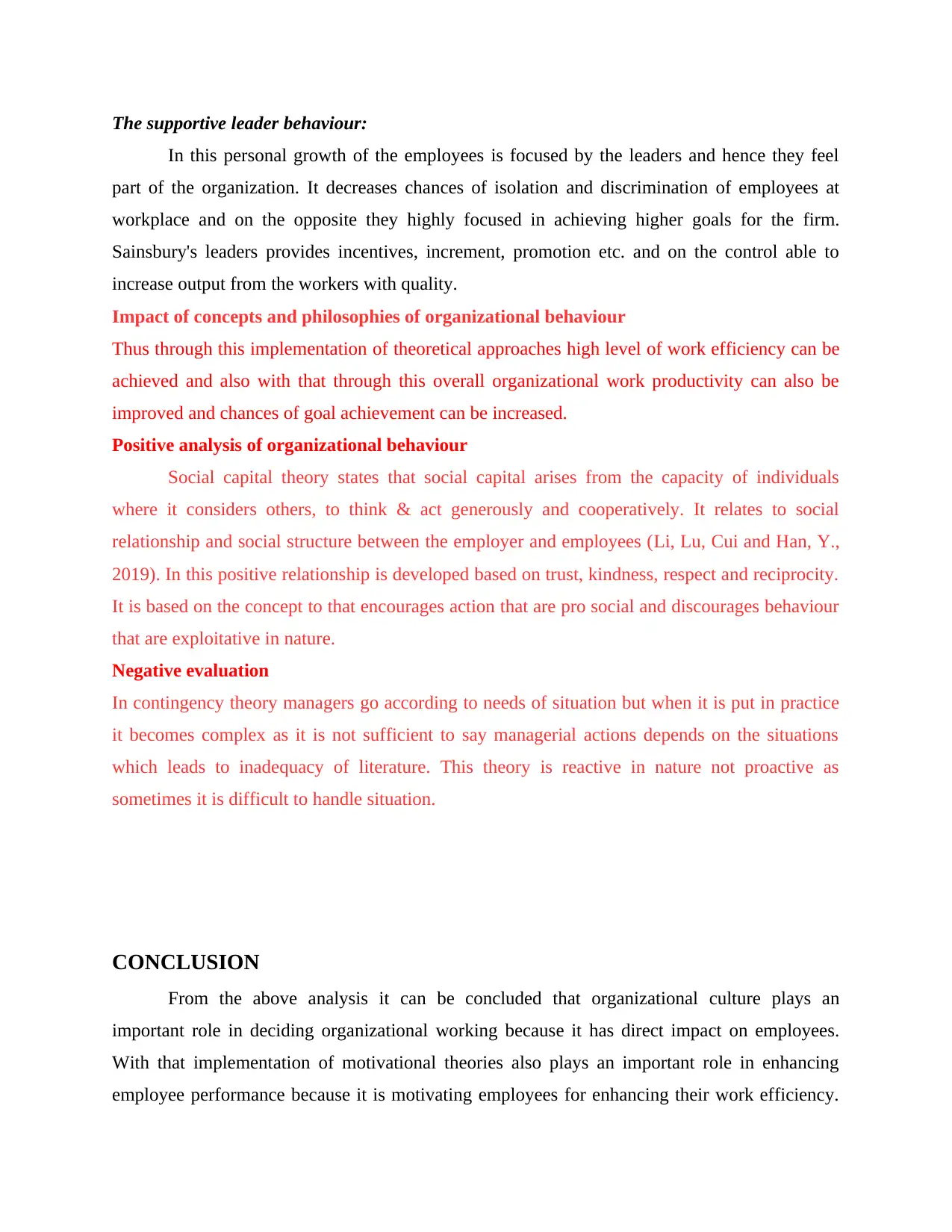
The supportive leader behaviour:
In this personal growth of the employees is focused by the leaders and hence they feel
part of the organization. It decreases chances of isolation and discrimination of employees at
workplace and on the opposite they highly focused in achieving higher goals for the firm.
Sainsbury's leaders provides incentives, increment, promotion etc. and on the control able to
increase output from the workers with quality.
Impact of concepts and philosophies of organizational behaviour
Thus through this implementation of theoretical approaches high level of work efficiency can be
achieved and also with that through this overall organizational work productivity can also be
improved and chances of goal achievement can be increased.
Positive analysis of organizational behaviour
Social capital theory states that social capital arises from the capacity of individuals
where it considers others, to think & act generously and cooperatively. It relates to social
relationship and social structure between the employer and employees (Li, Lu, Cui and Han, Y.,
2019). In this positive relationship is developed based on trust, kindness, respect and reciprocity.
It is based on the concept to that encourages action that are pro social and discourages behaviour
that are exploitative in nature.
Negative evaluation
In contingency theory managers go according to needs of situation but when it is put in practice
it becomes complex as it is not sufficient to say managerial actions depends on the situations
which leads to inadequacy of literature. This theory is reactive in nature not proactive as
sometimes it is difficult to handle situation.
CONCLUSION
From the above analysis it can be concluded that organizational culture plays an
important role in deciding organizational working because it has direct impact on employees.
With that implementation of motivational theories also plays an important role in enhancing
employee performance because it is motivating employees for enhancing their work efficiency.
In this personal growth of the employees is focused by the leaders and hence they feel
part of the organization. It decreases chances of isolation and discrimination of employees at
workplace and on the opposite they highly focused in achieving higher goals for the firm.
Sainsbury's leaders provides incentives, increment, promotion etc. and on the control able to
increase output from the workers with quality.
Impact of concepts and philosophies of organizational behaviour
Thus through this implementation of theoretical approaches high level of work efficiency can be
achieved and also with that through this overall organizational work productivity can also be
improved and chances of goal achievement can be increased.
Positive analysis of organizational behaviour
Social capital theory states that social capital arises from the capacity of individuals
where it considers others, to think & act generously and cooperatively. It relates to social
relationship and social structure between the employer and employees (Li, Lu, Cui and Han, Y.,
2019). In this positive relationship is developed based on trust, kindness, respect and reciprocity.
It is based on the concept to that encourages action that are pro social and discourages behaviour
that are exploitative in nature.
Negative evaluation
In contingency theory managers go according to needs of situation but when it is put in practice
it becomes complex as it is not sufficient to say managerial actions depends on the situations
which leads to inadequacy of literature. This theory is reactive in nature not proactive as
sometimes it is difficult to handle situation.
CONCLUSION
From the above analysis it can be concluded that organizational culture plays an
important role in deciding organizational working because it has direct impact on employees.
With that implementation of motivational theories also plays an important role in enhancing
employee performance because it is motivating employees for enhancing their work efficiency.
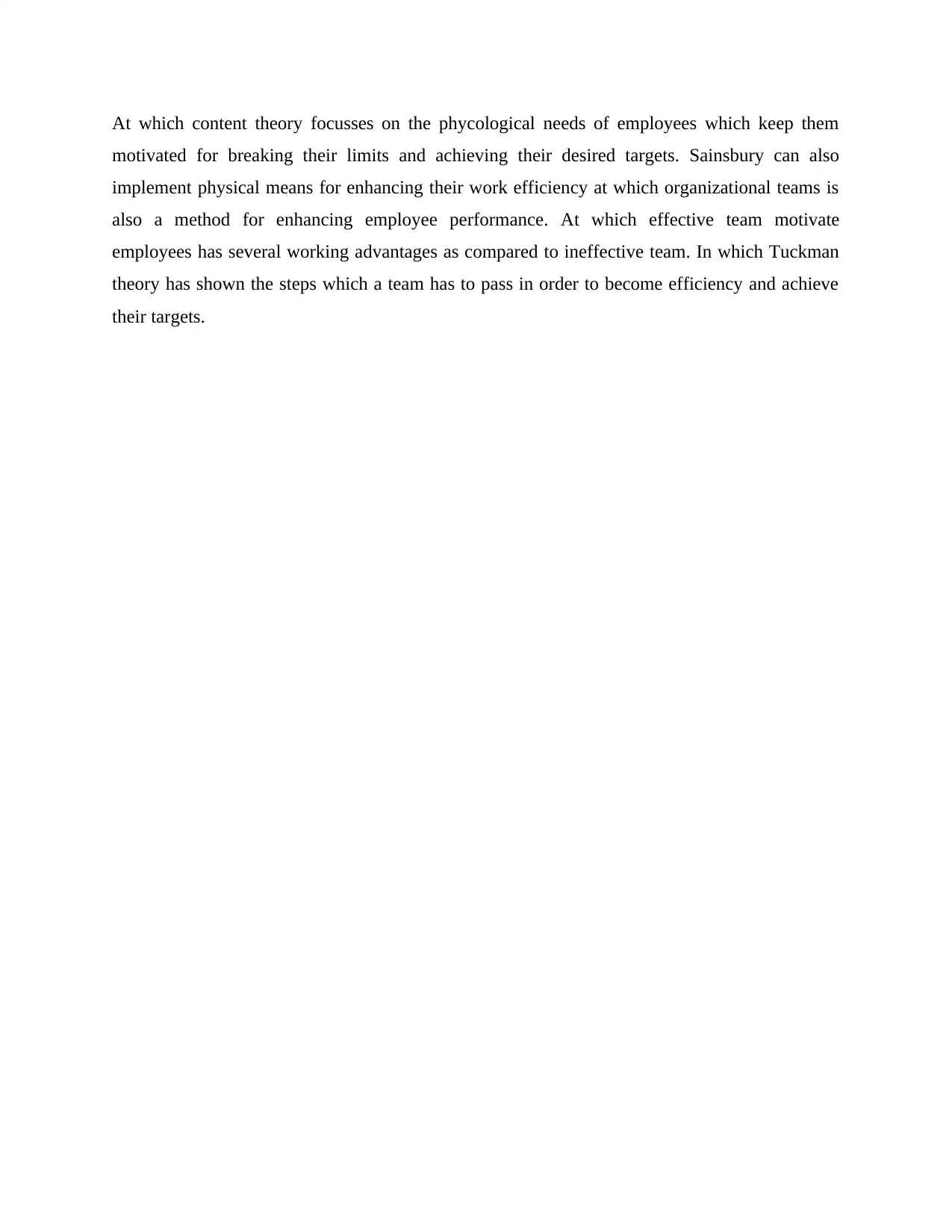
At which content theory focusses on the phycological needs of employees which keep them
motivated for breaking their limits and achieving their desired targets. Sainsbury can also
implement physical means for enhancing their work efficiency at which organizational teams is
also a method for enhancing employee performance. At which effective team motivate
employees has several working advantages as compared to ineffective team. In which Tuckman
theory has shown the steps which a team has to pass in order to become efficiency and achieve
their targets.
motivated for breaking their limits and achieving their desired targets. Sainsbury can also
implement physical means for enhancing their work efficiency at which organizational teams is
also a method for enhancing employee performance. At which effective team motivate
employees has several working advantages as compared to ineffective team. In which Tuckman
theory has shown the steps which a team has to pass in order to become efficiency and achieve
their targets.
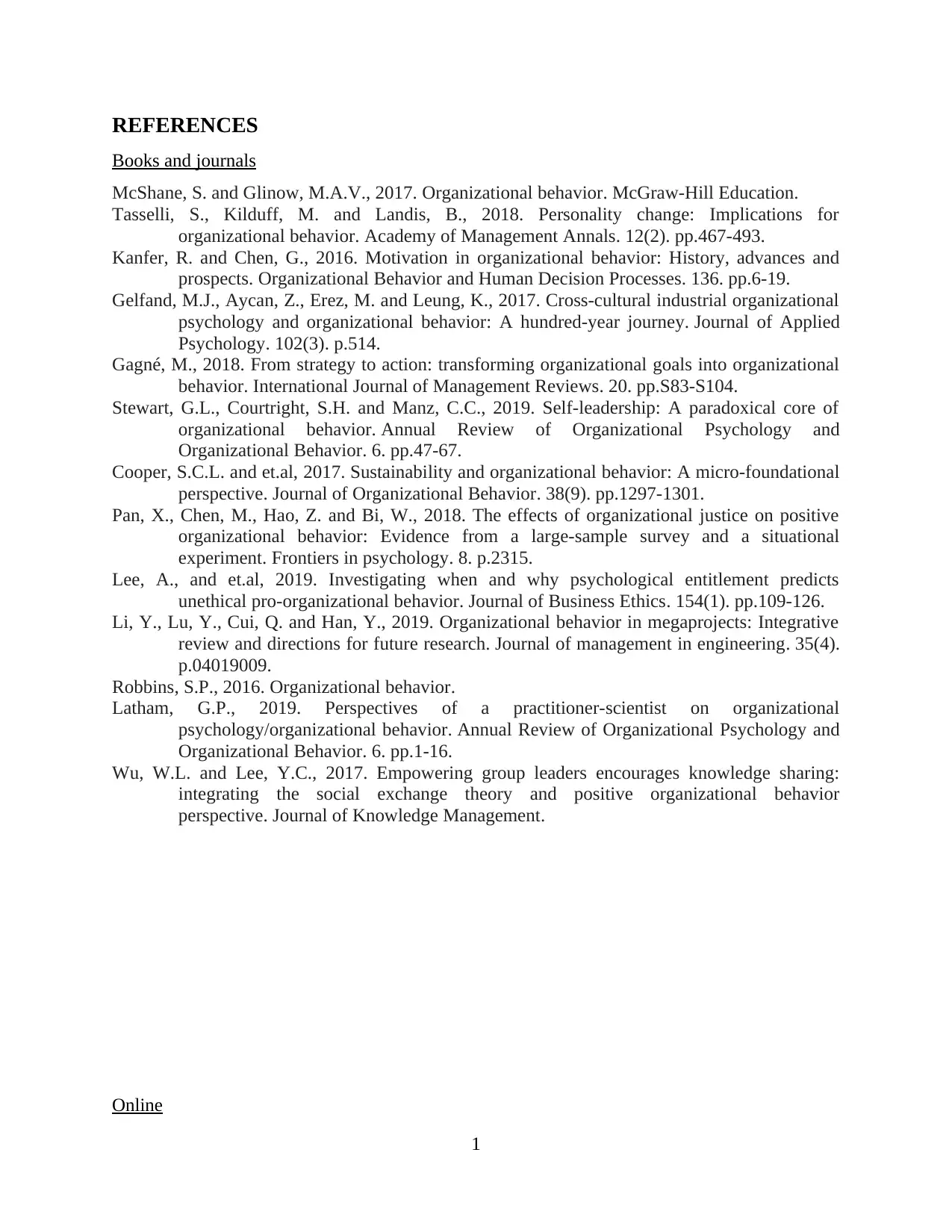
REFERENCES
Books and journals
McShane, S. and Glinow, M.A.V., 2017. Organizational behavior. McGraw-Hill Education.
Tasselli, S., Kilduff, M. and Landis, B., 2018. Personality change: Implications for
organizational behavior. Academy of Management Annals. 12(2). pp.467-493.
Kanfer, R. and Chen, G., 2016. Motivation in organizational behavior: History, advances and
prospects. Organizational Behavior and Human Decision Processes. 136. pp.6-19.
Gelfand, M.J., Aycan, Z., Erez, M. and Leung, K., 2017. Cross-cultural industrial organizational
psychology and organizational behavior: A hundred-year journey. Journal of Applied
Psychology. 102(3). p.514.
Gagné, M., 2018. From strategy to action: transforming organizational goals into organizational
behavior. International Journal of Management Reviews. 20. pp.S83-S104.
Stewart, G.L., Courtright, S.H. and Manz, C.C., 2019. Self-leadership: A paradoxical core of
organizational behavior. Annual Review of Organizational Psychology and
Organizational Behavior. 6. pp.47-67.
Cooper, S.C.L. and et.al, 2017. Sustainability and organizational behavior: A micro‐foundational
perspective. Journal of Organizational Behavior. 38(9). pp.1297-1301.
Pan, X., Chen, M., Hao, Z. and Bi, W., 2018. The effects of organizational justice on positive
organizational behavior: Evidence from a large-sample survey and a situational
experiment. Frontiers in psychology. 8. p.2315.
Lee, A., and et.al, 2019. Investigating when and why psychological entitlement predicts
unethical pro-organizational behavior. Journal of Business Ethics. 154(1). pp.109-126.
Li, Y., Lu, Y., Cui, Q. and Han, Y., 2019. Organizational behavior in megaprojects: Integrative
review and directions for future research. Journal of management in engineering. 35(4).
p.04019009.
Robbins, S.P., 2016. Organizational behavior.
Latham, G.P., 2019. Perspectives of a practitioner-scientist on organizational
psychology/organizational behavior. Annual Review of Organizational Psychology and
Organizational Behavior. 6. pp.1-16.
Wu, W.L. and Lee, Y.C., 2017. Empowering group leaders encourages knowledge sharing:
integrating the social exchange theory and positive organizational behavior
perspective. Journal of Knowledge Management.
Online
1
Books and journals
McShane, S. and Glinow, M.A.V., 2017. Organizational behavior. McGraw-Hill Education.
Tasselli, S., Kilduff, M. and Landis, B., 2018. Personality change: Implications for
organizational behavior. Academy of Management Annals. 12(2). pp.467-493.
Kanfer, R. and Chen, G., 2016. Motivation in organizational behavior: History, advances and
prospects. Organizational Behavior and Human Decision Processes. 136. pp.6-19.
Gelfand, M.J., Aycan, Z., Erez, M. and Leung, K., 2017. Cross-cultural industrial organizational
psychology and organizational behavior: A hundred-year journey. Journal of Applied
Psychology. 102(3). p.514.
Gagné, M., 2018. From strategy to action: transforming organizational goals into organizational
behavior. International Journal of Management Reviews. 20. pp.S83-S104.
Stewart, G.L., Courtright, S.H. and Manz, C.C., 2019. Self-leadership: A paradoxical core of
organizational behavior. Annual Review of Organizational Psychology and
Organizational Behavior. 6. pp.47-67.
Cooper, S.C.L. and et.al, 2017. Sustainability and organizational behavior: A micro‐foundational
perspective. Journal of Organizational Behavior. 38(9). pp.1297-1301.
Pan, X., Chen, M., Hao, Z. and Bi, W., 2018. The effects of organizational justice on positive
organizational behavior: Evidence from a large-sample survey and a situational
experiment. Frontiers in psychology. 8. p.2315.
Lee, A., and et.al, 2019. Investigating when and why psychological entitlement predicts
unethical pro-organizational behavior. Journal of Business Ethics. 154(1). pp.109-126.
Li, Y., Lu, Y., Cui, Q. and Han, Y., 2019. Organizational behavior in megaprojects: Integrative
review and directions for future research. Journal of management in engineering. 35(4).
p.04019009.
Robbins, S.P., 2016. Organizational behavior.
Latham, G.P., 2019. Perspectives of a practitioner-scientist on organizational
psychology/organizational behavior. Annual Review of Organizational Psychology and
Organizational Behavior. 6. pp.1-16.
Wu, W.L. and Lee, Y.C., 2017. Empowering group leaders encourages knowledge sharing:
integrating the social exchange theory and positive organizational behavior
perspective. Journal of Knowledge Management.
Online
1
Paraphrase This Document
Need a fresh take? Get an instant paraphrase of this document with our AI Paraphraser
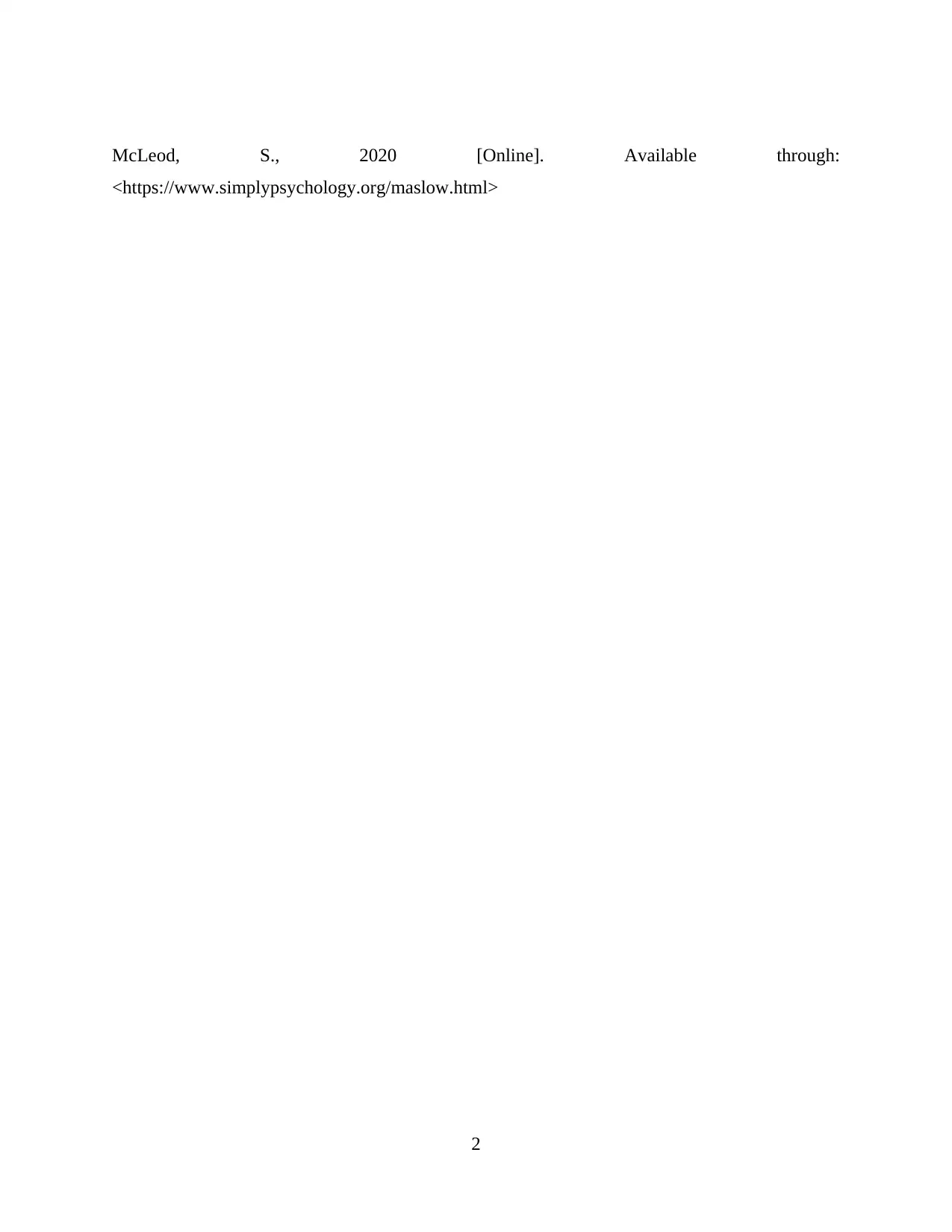
McLeod, S., 2020 [Online]. Available through:
<https://www.simplypsychology.org/maslow.html>
2
<https://www.simplypsychology.org/maslow.html>
2
1 out of 14
Related Documents
Your All-in-One AI-Powered Toolkit for Academic Success.
+13062052269
info@desklib.com
Available 24*7 on WhatsApp / Email
![[object Object]](/_next/static/media/star-bottom.7253800d.svg)
Unlock your academic potential
© 2024 | Zucol Services PVT LTD | All rights reserved.





